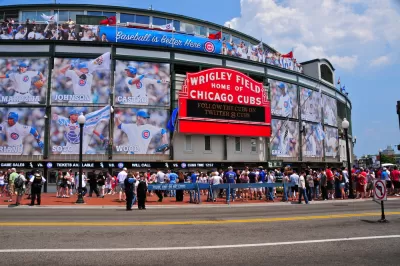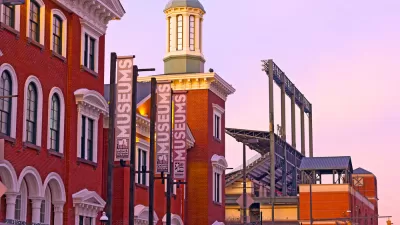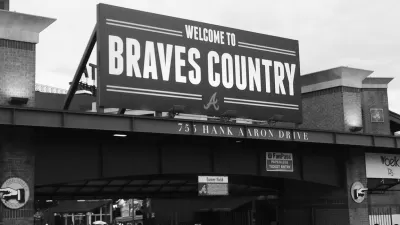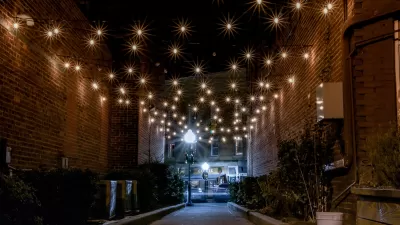A new book looks at the evolution of American ballparks and the changes that have mirrored urbanism.

Ballpark: Baseball in the American City is a new book from Paul Goldberger that traces the history of ballparks in the United States. "From the utilitarian beauty of early 20th-century ballparks like Chicago’s Wrigley Field and Boston’s Fenway Park—each nestled into its respective neighborhood—to the doughnut-shaped, concrete structures that sprouted in suburbia after World War II, baseball’s growth has neatly paralleled the rise, fall, and rise again of U.S. cities," says Patrick Sisson.
The first ballparks sprung up in cities, and they were very enmeshed in the urban landscape. In postwar America, they moved to the suburbs, writes Sisson. "This was the time of the 'concrete doughnuts,' which Goldberger argues were bland, multipurpose, municipal parks often set far from the city center, ones like Oakland Coliseum, Fulton County Stadium in Atlanta, and Philadelphia’s Veterans Stadium."
Ballparks then returned to the city, along with urban renewal. The most recent era, according to Goldberger, is one where ballparks are part of commercial and entertainment megadevelopments. "With Atlanta’s new park, as well as recent developments around the St. Louis ballpark and Chicago’s Wrigley Field—where the surrounding Wrigleyville neighborhood is gradually being turned into a more generic, mall-like destination—Goldberger is disappointed to see team owners trying to control the city inside and outside of the gate," notes Sisson.
FULL STORY: Looking at the changing American city through its ballparks

Study: Maui’s Plan to Convert Vacation Rentals to Long-Term Housing Could Cause Nearly $1 Billion Economic Loss
The plan would reduce visitor accommodation by 25,% resulting in 1,900 jobs lost.

North Texas Transit Leaders Tout Benefits of TOD for Growing Region
At a summit focused on transit-oriented development, policymakers discussed how North Texas’ expanded light rail system can serve as a tool for economic growth.

Why Should We Subsidize Public Transportation?
Many public transit agencies face financial stress due to rising costs, declining fare revenue, and declining subsidies. Transit advocates must provide a strong business case for increasing public transit funding.

How to Make US Trains Faster
Changes to boarding platforms and a switch to electric trains could improve U.S. passenger rail service without the added cost of high-speed rail.

Columbia’s Revitalized ‘Loop’ Is a Hub for Local Entrepreneurs
A focus on small businesses is helping a commercial corridor in Columbia, Missouri thrive.

Invasive Insect Threatens Minnesota’s Ash Forests
The Emerald Ash Borer is a rapidly spreading invasive pest threatening Minnesota’s ash trees, and homeowners are encouraged to plant diverse replacement species, avoid moving ash firewood, and monitor for signs of infestation.
Urban Design for Planners 1: Software Tools
This six-course series explores essential urban design concepts using open source software and equips planners with the tools they need to participate fully in the urban design process.
Planning for Universal Design
Learn the tools for implementing Universal Design in planning regulations.
City of Santa Clarita
Ascent Environmental
Institute for Housing and Urban Development Studies (IHS)
City of Grandview
Harvard GSD Executive Education
Toledo-Lucas County Plan Commissions
Salt Lake City
NYU Wagner Graduate School of Public Service





























